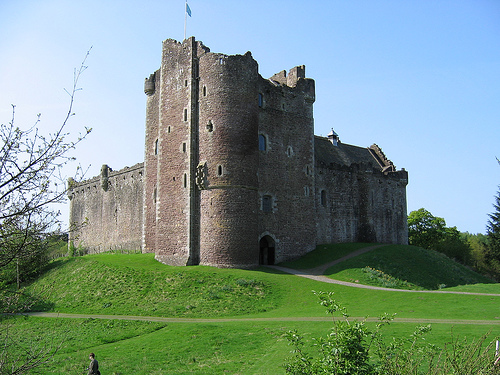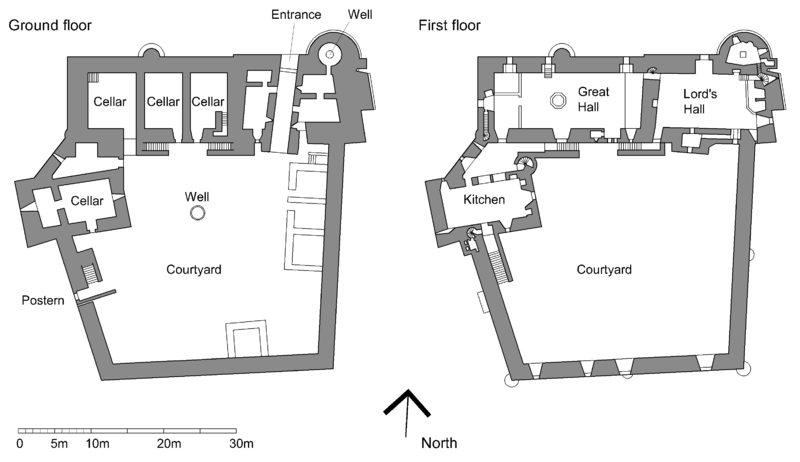

Location: Doune, Stirling Map
Constructed: late 14th century
Tel. 01786 841742
Open: Apr- Sep: 9:30am- 5:30pm daily
Oct- Mar 9:30am- 4:30pm Sat- Wed
(last admission 30 minutes before closing)
Closed: 21 Dec- 8 Jan

Doune Castle, perched above the River Teith in Stirlingshire, Scotland, is a formidable medieval stronghold that encapsulates centuries of Scottish history, architectural evolution, and cultural significance. Built in the late 14th century, it served as a noble residence, military fortress, and royal retreat, surviving wars, rebellions, and changing fortunes to become one of Scotland’s best-preserved castles. Its fame extends beyond history, thanks to its starring role in films like Monty Python and the Holy Grail and TV series such as Outlander and Game of Thrones. Managed by Historic Environment Scotland, Doune remains a captivating site, blending rugged stonework with evocative ruins and lush surroundings.
Origins and the Albany Stewarts (Late 14th Century)
Doune Castle was constructed around 1380–1400 by Robert Stewart, Duke of
Albany (c. 1340–1420), a towering figure in medieval Scotland. As the
third son of King Robert II, Albany wielded immense power as Governor of
Scotland, effectively ruling during the reigns of his father, brother
(Robert III), and nephew (James I). The castle replaced an earlier
fortification, possibly Roman or Dark Age, on the site, chosen for its
strategic position controlling routes between Stirling, the Highlands,
and the Lowlands.
Albany built Doune as both a power base and a
luxurious residence, reflecting his near-royal status. Its robust
defenses signaled military might, while its spacious halls catered to a
grand household. After Albany’s death in 1420, his son Murdoch inherited
the castle, but the family’s fortunes collapsed in 1425 when James I,
freed from English captivity, executed Murdoch and his sons for treason,
seizing Doune for the crown.
Royal and Noble Tenure (15th–16th
Century)
As a royal castle, Doune hosted Scotland’s monarchs, notably
James I and Mary of Guelders, widow of James II, who died there in 1463.
It served as a dower house for queens, including Margaret Tudor, wife of
James IV, who held it after his death at Flodden (1513). The castle’s
defenses were tested during this period, though no major sieges are
recorded, reflecting its deterrent strength.
By the late 16th
century, the crown granted Doune to the Stewart Earls of Moray,
descendants of James V’s illegitimate son. James Stewart, the “Bonnie
Earl” of Moray, resided there until his murder in 1592 by the Gordons, a
feud immortalized in the ballad The Bonnie Earl o’ Moray. His widow,
Lady Agnes, maintained the castle, which passed through the Moray line,
hosting occasional royal visits, such as James VI’s stays.
Jacobite Rebellions and Decline (17th–18th Century)
Doune’s military
role resurfaced during the Jacobite Rebellions. In 1689, during the
first uprising, government troops garrisoned it against Highland clans
supporting James VII. The castle saw action again in the 1715 Rebellion,
with repairs made to house prisoners. Its most dramatic moment came
during the 1745 Rebellion, when Bonnie Prince Charlie’s Jacobites
captured Doune, imprisoning Hanoverian soldiers in its cellars. After
their defeat at Culloden (1746), government forces retook it, detaining
Jacobite prisoners, some of whom escaped via a latrine chute.
By
the late 18th century, Doune’s strategic value waned. The Moray family,
focused on other estates like Darnaway, neglected it, and the roof
collapsed around 1800, leaving the castle a ruin. Romanticized as a
relic, it drew early tourists, including Sir Walter Scott, who admired
its “grim grandeur.”
Restoration and Modern Era (19th
Century–Present)
In 1883, the 14th Earl of Moray began restoration,
reroofing the castle to preserve its structure. His successors continued
maintenance, and in 1984, the Moray family leased Doune to the state,
now managed by Historic Environment Scotland. Partial repairs, like
stabilizing the gatehouse, ensure accessibility, though much remains
evocatively unrestored.
Doune’s modern fame stems from its screen
appearances. Monty Python and the Holy Grail (1975) used it as multiple
locations—Castle Anthrax, Swamp Castle, and more—its courtyard
immortalized in the coconut-shell “horse galloping” scene. Outlander
(2014–present) cast it as Castle Leoch, home of Clan Mackenzie, while
Game of Thrones (2011) featured it as Winterfell in its pilot. These
roles boost tourism, with visitors flocking to reenact scenes or explore
its history. As of April 11, 2025, Doune remains a vibrant site, hosting
events like medieval reenactments and Outlander-themed tours.
Doune Castle is a courtyard castle, its L-shaped layout combining
defense with domesticity. Built of local sandstone, its walls rise
sheer from a grassy mound, flanked by the River Teith and Ardoch
Burn, enhancing natural defenses. The castle’s intact state—rare for
its age—offers a vivid snapshot of 14th-century architecture.
Gatehouse Tower
The gatehouse tower, dominating the north
front, is Doune’s most striking feature:
Rising 25 meters (80
feet), it houses the lord’s residence across four floors.
A
vaulted entrance passage, once secured by a portcullis and double
doors, leads to the courtyard. Above, a first-floor Lord’s Hall (14
x 7 meters) boasts a double fireplace, window seats, and a carved
oak screen, reflecting Albany’s wealth. A private chamber and
latrine adjoin, with a trapdoor to a bottle-shaped dungeon below.
Upper floors include a guest chamber and a small treasury room,
accessible via spiral stairs. The battlements, restored in the 19th
century, offer panoramic views of Ben Lomond and Stirling.
Shot-holes and arrow slits underscore its defensive role, though
large windows suggest confidence in its deterrent power.
Great Hall and Kitchen Tower
The Great Hall, forming the castle’s
eastern range, is a masterpiece of medieval design:
Measuring 20
x 8 meters, it sits above vaulted cellars, reached by a broad stair
from the courtyard. Its timber roof, restored in 1883, spans a space
lit by tall windows, with a minstrels’ gallery and a central hearth
(now floored over).
A serving hatch connects to the kitchen
tower, a cylindrical block with a massive fireplace (3 meters wide)
for roasting oxen, a baking oven, and a slop drain. A servery and
pantry link to the hall, supporting feasts for hundreds.
The
kitchen’s upper floors housed staff or lesser guests, with a spiral
stair to the battlements.
Courtyard and Ancillary Structures
The courtyard, roughly 30 x 25 meters, is enclosed by high curtain
walls, largely intact:
A well, 14 meters deep, supplied water,
vital during sieges.
Timber ranges, now gone, once lined the
walls, housing stables, a brewhouse, and servants’ quarters. Their
stone footings remain.
A postern gate near the kitchen tower
allowed discreet access to the river, possibly for supplies or
escape.
The castle’s design prioritizes self-sufficiency,
with storage for grain, wine, and ale in cellars, and ovens for
daily bread. Its layout—centralized yet fortified—reflects Albany’s
need to project power while hosting allies.
Condition and
Restoration
Unlike many Scottish castles, Doune escaped heavy
bombardment, preserving its core structure. The 1883 reroofing saved
the interiors, though weathering has softened details like window
tracery. The dungeon, cellars, and upper chambers remain
atmospheric, with graffiti from 18th-century prisoners adding
character. Ongoing maintenance, funded by Historic Scotland and
visitor revenue, ensures stability, though some areas, like the
battlements, are periodically closed for safety.
Doune’s setting enhances its allure:
Natural Defenses: The castle
sits on a low ridge, with the Teith to the west and Ardoch Burn to the
south, creating a moat-like barrier. Marshy ground once deterred siege
engines.
Landscaping: The immediate grounds are simple—grassy slopes
and a gravel path—but the surrounding estate, still Moray-owned,
includes woodlands and fields. A short walk along the Teith leads to
Doune village, with its 19th-century pistol factory and bridge.
Views: From the battlements, visitors see Stirling Castle (8 miles
east), the Ochil Hills, and Highland peaks, tying Doune to Scotland’s
broader landscape.
No formal gardens survive, unlike Dirleton
Castle, but the castle’s stark beauty needs little adornment. A small
ticket office and shop sit outside, minimizing intrusion.
Doune Castle embodies medieval Scotland’s power dynamics and cultural
shifts:
Political Hub: As Albany’s seat, it hosted negotiations and
feasts, shaping Stewart dominance. Its royal use under queens like
Margaret Tudor underscores its prestige.
Jacobite Legacy: The 1745
imprisonment of Hanoverians and Jacobites ties Doune to Scotland’s
divided loyalties, with escape tales adding folklore.
Literary
Echoes: Sir Walter Scott’s Waverley (1814), set partly in a
fictionalized Doune, cemented its Romantic image, inspiring 19th-century
tourism.
Screen Icon: Monty Python made Doune a cult destination,
with fans quoting “Your mother was a hamster!” in its courtyard.
Outlander and Game of Thrones deepened its global reach, portraying it
as a clan stronghold or northern fortress, blending history with
fantasy.
Community Anchor: Doune village (pop. 2,200) thrives on
castle tourism, with local pubs like the Woodside Hotel serving
Outlander-themed drams. Annual events, like medieval fairs, draw
families.
The castle’s versatility—fortress, palace, prison,
ruin, and film set—mirrors Scotland’s own adaptability, making it a
cultural touchstone.
Located 8 miles northwest of Stirling off the A84, Doune is
accessible by car (free parking) or bus (routes 59, X10A from Stirling,
20-minute ride). Doune railway station, 1 mile away, connects to
Edinburgh (50 minutes). Opening hours are:
April 1–September 30:
Daily, 9:30 AM–5:00 PM (last entry 4:30 PM).
October 1–March 31:
Daily, 10:00 AM–4:00 PM (last entry 3:30 PM).
Admission (2025
rates) is £10 for adults, £6 for children (5–15), free for Historic
Scotland members, and half-price for English Heritage/Cadw members
(booking advised). An audio guide, narrated by Monty Python’s Terry
Jones and Outlander’s Sam Heughan, adds humor and context, covering
history and filming anecdotes.
The castle is largely accessible,
with a level courtyard and ground-floor rooms, though spiral stairs to
the Lord’s Hall and battlements (74 steps) challenge mobility-impaired
visitors. Children delight in exploring cellars and reenacting Monty
Python scenes, but parents should mind steep drops. Dogs are allowed in
the grounds (leashed, not indoors). A picnic area by the Teith suits
families, and the shop sells Holy Grail-inspired coconut shells.
Visitors can wander the Great Hall, peer into the dungeon, or climb to
the battlements for Highland views. Nearby attractions include Stirling
Castle, the Wallace Monument, and Blair Drummond Safari Park, making
Doune a hub for Central Scotland exploration.
Doune faces preservation hurdles typical of medieval sites:
Weathering: Rain and frost erode sandstone, particularly window sills
and parapets, requiring regular repointing.
Tourism Pressure: Film
fame draws 70,000+ visitors yearly, straining paths and facilities.
Historic Scotland caps group sizes to protect interiors.
Funding:
Maintenance relies on ticket sales and memberships, with budget
constraints limiting full restoration of minor structures like the
brewhouse.
Recent efforts include drainage improvements (2023) to
prevent cellar flooding and safety checks on the gatehouse. Climate
change, increasing rainfall, prompts long-term planning, like
reinforcing riverbanks. Doune’s lease to Historic Scotland ensures Moray
family involvement, balancing heritage with public access.